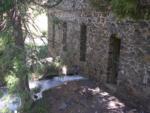Modeling Tool to Assess and Mitigate the Effects of Small Hydropower on Stream Fishes in a Changing California Climate
-
IssueCalifornia’s 2005 Energy Policy Act (EPAct) provides incentives for new hydropower development that could be used to encourage development of additional hydropower capacity in California. Meanwhile, California’s mandate to increase the contribution of renewable energy sources and reduce greenhouse gas emissions has led to incentives to increase the production of energy from small hydropower as part of California’s Renewable Portfolio Standard. However, this may come with costs to native fish species.

-
Objectives
We aim to develop tools to make more efficient and intelligent water management decisions. Proponents of hydroelectric power generation in California frequently find themselves in conflict with proponents of fish over water allocation, yet the impacts of hydropower production and effectiveness of mitigation strategies are often unclear. As a result, hydropower producers are forced to aggressively explore different water management options designed to maintain sufficient water supply for generation within the context of changing social values favoring fish. Complicating an already complex dilemma, climate change may alter the quantity and timing of water availability in coming decades, potentially heightening conflicts. Further adding to the environmental challenges, there is currently no general integrated analytical framework for the exploration of trade-offs between competing use of water by small hydropower and fish, nor one that takes into consideration climate change forecasts from global general circulation models. Such uncertainties could cause unnecessary curtailment of small hydropower production due to environmental concerns.
-
Research Activities
In this project we will develop and test the feasibility of a fish habitat suitability model optimized to assess the impacts and mitigation potential of small hydropower facilities. The purpose of this exploratory two-year project is to build and test a model designed to function seamlessly within an integrated modeling framework that will include 1) a watershed hydrology and water management model, and (2) a fish habitat suitability model. Because the models will be designed to be easily modified for different watersheds and fish populations, they may be used to assess environmental effects of numerous small hydropower projects in more than one watershed simultaneously.
-
ResultsN / A
-
Outcomes and ImpactsN / A
-
PhotosN / A
-
Supporting Information
Webinar recording of Model Workshop, held on March 25, 2015 in Sacramento, CA. Demonstration of WEAPhish fish habitat and population dynamics model, and Master_WEAPhish middle ware link to WEAP watershed hydrology and management model. Running time: 1:20:44.00 (1 hour 21 minutes).
WEAPhish Model Workshop, 2015. Demonstration of WEAPhish fish habitat & population dynamics model, & Master_WEAPhish middle ware link to WEAP model.
-
AcknowledgementsN / A
-
For more information contact
This project is supported by the California Institute for Energy and the Environment (CIEE, a branch of the University of California Energy Institute) with funding from the California Energy Commission (CEC).

